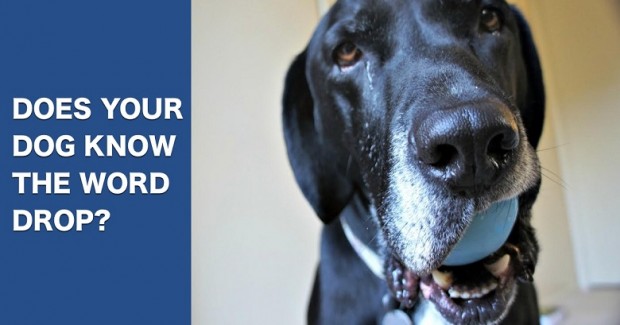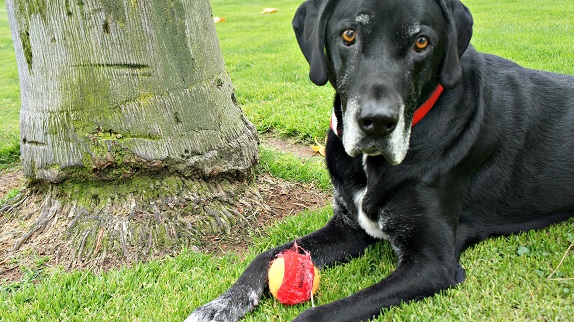Do you use “drop” to get your dog to drop something he has in his mouth?
And does he listen?
It’s one of the most important words to teach a dog but often overlooked.
“Drop” can prevent your dog from eating something dangerous and can even save his life.
It’s also a helpful way to communicate when you want your dog to drop a toy or rawhide without getting bitten and without chasing him (we’ve all played that game!).
Finally, teaching a dog to drop – and that good things happen when he does – is a good way to prevent possessiveness of toys and bones. It’s not necessarily going to eliminate the problem completely, but it’s a start.
A couple examples where “drop” can come in handy:
- Telling your dog to drop a cooked chicken bone or other garbage.
- Asking him to drop a rawhide or toy.
- Telling him to drop a dead snake he found in the yard.
Let me know in the comments some examples of when you’ve had to use the “drop” command.
Unlike the obvious commands like sit and come, “drop” is something new dog owners may not even think about teaching. “Leave it” is another good one to teach.
Simple steps – how to teach a dog to drop
When teaching a dog to drop, what you need to know is this:
1. Hold highly valued food and tell your dog to “drop” a boring item like a toy. Then, immediately reward him with the food.
2. Another option is not to say anything. Instead, wait for your dog to drop the item on his own. Then, say “yes!” and reward with the food.
The dog eventually thinks, “Wow, good things happen when I drop this toy.” After several repetitions, start adding the verbal cue “drop.”
Other tips for teaching drop
1. Make “drop” ridiculously easy.
The dog should be holding a boring toy and the reward should be high.
Eventually, you can challenge him to drop slightly more “valuable” items. After that, work on asking him to drop “ultimate” items like rawhides. Or dead squirrels? 🙂
With time, you can weed out the reward about half the time. That way he’ll still be eager to drop on cue in anticipation of a reward.
2 Practice in controlled scenarios.
You don’t want to practice drop when your dog has grabbed a cookie off the counter and there’s no way in hell he’s going to drop it.
Instead, practice when you can follow through and make sure your dog actually does drop the item. That way he learns it’s best to listen to you. He gets a reward, and his response becomes almost automatic.
What if my dog won’t drop the item?
This can be so frustrating!
If your dog refuses to drop the item or if he’s showing aggression, use your best judgement and do be careful. I have written a post on possessiveness here.
Here are some suggestions:
1. Find a better food reward.
Try real chicken, bacon, hot dogs or beef jerky.
You also may need more practice getting your dog to drop “boring” toys and items before you move on to higher-valued items.
2. Give the original item right back.
Another trick you can use is to give the original item right back as the reward for “drop.”
Some dogs know you’re going to take away that prized item (and sometimes you have to), so they hang onto it with all their might.
If it’s safe to let your dog keep whatever he has, by all means, use that as the reward! “Good boy!”
For my dog, the best reward is simply throwing the ball he just dropped. No food reward necessary for my Retrieving Nut! He will drop absolutely anything if it means I’ll throw the ball. Oh, Ace. You’re so simple sometimes. 🙂
You know your dog best. Get creative and use what works.
What tricks or tips have you used for teaching your dog to Drop on command?
Another good one to teach is “leave it” which I wrote about here.
Related posts:
Teach a dog to drop to stop possessiveness
My dog steals toys at the dog park
Teaching a dog to leave it



Miranda
Sunday 5th of November 2017
This is helpful but my question is how do you move from training to getting your dog to follow when they don’t want to? My puppy is 4 months (maybe it’s too early) and he is good with come and drop when we are training with treats but not when he wants to stay in the yard or he actually got a hold of something he wants. Is there an interim step? Thanks!
JaneO
Monday 28th of August 2017
Working on drop at the moment! Blu (my very large rescue GSD) has got the hang of leaving (as he walks up to what he wants to take), but wasn't great at dropping (especially his ball). However, rightly or wrongly, I opened his mouth (with my hand) and took ball out at the same time as saying DROP - difficult to start with! I now don't have to open his mouth manually, he just drops the ball as I take it out of his mouth. And then I immediately throw it for him. Works a treat!!
Jean Patterson
Tuesday 6th of December 2016
Great post Lindsay, very important to teach this command. I have two very rambunctious Rotties and this was one of the first commands they learned!
Emma
Tuesday 30th of August 2016
On our walk this morning, Mom was just saying to Bailie how good she is at drop. She is one to pick up all kinds of stuff, but she drops it when asked. It is a very important command.
Lindsay Stordahl
Tuesday 30th of August 2016
Remy is terrible with "drop" but good with "leave it."
Barbara Rivers
Saturday 13th of June 2015
Haha, Buzz is the same way as Ace - he always willingly drops his chuck-it ball and can't wait for us to throw it again :-) Repeat, repeat, repeat... We taught both of our pups the command "leave it" for not touching something as well as dropping something they have in their mouths.